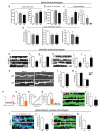DIXDC1 contributes to psychiatric susceptibility by regulating dendritic spine and glutamatergic synapse density via GSK3 and Wnt/β-catenin signaling
- PMID: 27752079
- PMCID: PMC5395363
- DOI: 10.1038/mp.2016.184
DIXDC1 contributes to psychiatric susceptibility by regulating dendritic spine and glutamatergic synapse density via GSK3 and Wnt/β-catenin signaling
Abstract
Mice lacking DIX domain containing-1 (DIXDC1), an intracellular Wnt/β-catenin signal pathway protein, have abnormal measures of anxiety, depression and social behavior. Pyramidal neurons in these animals' brains have reduced dendritic spines and glutamatergic synapses. Treatment with lithium or a glycogen synthase kinase-3 (GSK3) inhibitor corrects behavioral and neurodevelopmental phenotypes in these animals. Analysis of DIXDC1 in over 9000 cases of autism, bipolar disorder and schizophrenia reveals higher rates of rare inherited sequence-disrupting single-nucleotide variants (SNVs) in these individuals compared with psychiatrically unaffected controls. Many of these SNVs alter Wnt/β-catenin signaling activity of the neurally predominant DIXDC1 isoform; a subset that hyperactivate this pathway cause dominant neurodevelopmental effects. We propose that rare missense SNVs in DIXDC1 contribute to psychiatric pathogenesis by reducing spine and glutamatergic synapse density downstream of GSK3 in the Wnt/β-catenin pathway.
Figures





Similar articles
-
DIXDC1 Phosphorylation and Control of Dendritic Morphology Are Impaired by Rare Genetic Variants.Cell Rep. 2016 Nov 8;17(7):1892-1904. doi: 10.1016/j.celrep.2016.10.047. Cell Rep. 2016. PMID: 27829159
-
DIX domain containing 1 (DIXDC1) modulates VEGFR2 level in vasculatures to regulate embryonic and postnatal retina angiogenesis.BMC Biol. 2022 Feb 10;20(1):41. doi: 10.1186/s12915-022-01240-3. BMC Biol. 2022. PMID: 35144597 Free PMC article.
-
DIXDC1 activates the Wnt signaling pathway and promotes gastric cancer cell invasion and metastasis.Mol Carcinog. 2016 Apr;55(4):397-408. doi: 10.1002/mc.22290. Epub 2015 Feb 3. Mol Carcinog. 2016. PMID: 25648220
-
Axin: an emerging key scaffold at the synapse.IUBMB Life. 2013 Aug;65(8):685-91. doi: 10.1002/iub.1184. Epub 2013 Jul 11. IUBMB Life. 2013. PMID: 23847014 Review.
-
Wnt and GSK3 Signaling Pathways in Bipolar Disorder: Clinical and Therapeutic Implications.Clin Psychopharmacol Neurosci. 2017 May 31;15(2):100-114. doi: 10.9758/cpn.2017.15.2.100. Clin Psychopharmacol Neurosci. 2017. PMID: 28449557 Free PMC article. Review.
Cited by
-
Tet1-mediated 5hmC regulates hippocampal neuroinflammation via wnt signaling as a novel mechanism in obstructive sleep apnoea leads to cognitive deficit.J Neuroinflammation. 2024 Aug 21;21(1):208. doi: 10.1186/s12974-024-03189-2. J Neuroinflammation. 2024. PMID: 39169375 Free PMC article.
-
Suppression of Disheveled-Axin Domain Containing 1 (DIXDC1) by MicroRNA-186 Inhibits the Proliferation and Invasion of Retinoblastoma Cells.J Mol Neurosci. 2018 Feb;64(2):252-261. doi: 10.1007/s12031-017-1017-7. Epub 2017 Dec 20. J Mol Neurosci. 2018. PMID: 29264763
-
The role of the microbiota-gut-brain axis in methamphetamine-induced neurotoxicity: Disruption of microbial composition and short-chain fatty acid metabolism.Acta Pharm Sin B. 2024 Nov;14(11):4832-4857. doi: 10.1016/j.apsb.2024.08.012. Epub 2024 Aug 14. Acta Pharm Sin B. 2024. PMID: 39664442 Free PMC article.
-
Wnt/β-Catenin-Dependent Transcription in Autism Spectrum Disorders.Front Mol Neurosci. 2021 Nov 11;14:764756. doi: 10.3389/fnmol.2021.764756. eCollection 2021. Front Mol Neurosci. 2021. PMID: 34858139 Free PMC article. Review.
-
Neurodevelopmental Perspectives on Wnt Signaling in Psychiatry.Mol Neuropsychiatry. 2017 Feb;2(4):219-246. doi: 10.1159/000453266. Epub 2017 Jan 13. Mol Neuropsychiatry. 2017. PMID: 28277568 Free PMC article. Review.
References
-
- Shiomi K, Uchida H, Keino-Masu K, Masu M. Ccd1, a novel protein with a DIX domain, is a positive regulator in the Wnt signaling during zebrafish neural patterning. Curr Biol. 2003 Jan 8;13(1):73–7. - PubMed
Publication types
MeSH terms
Substances
Grants and funding
LinkOut - more resources
Full Text Sources
Other Literature Sources

